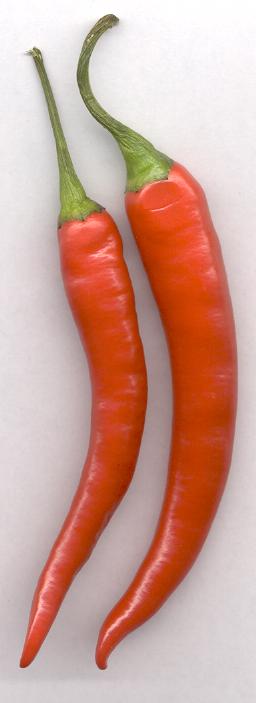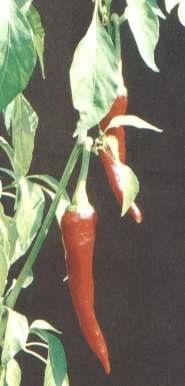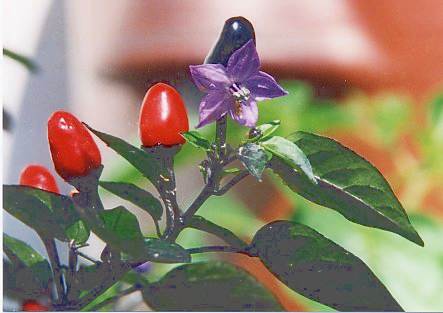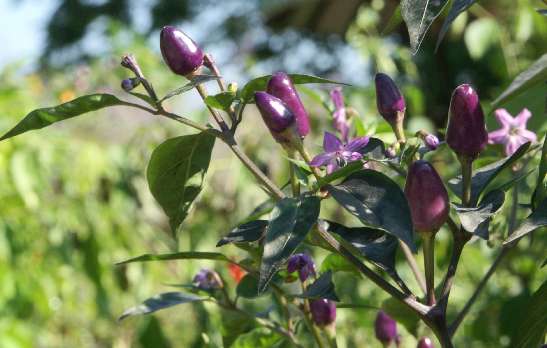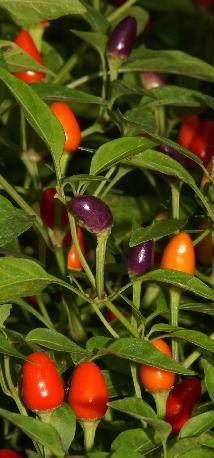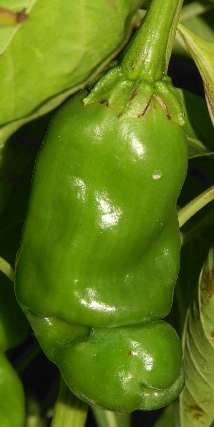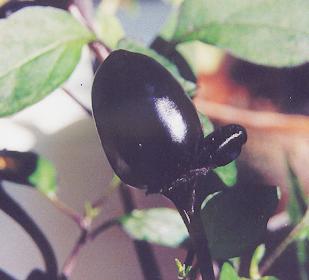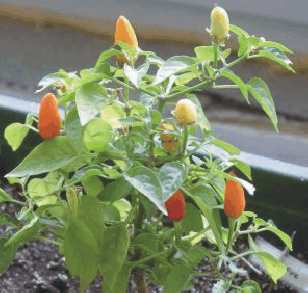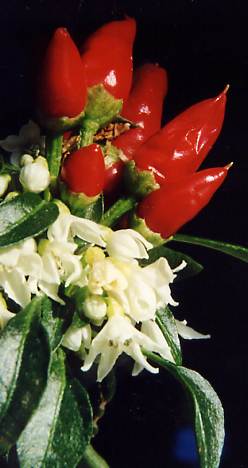
|
|
Ornamental chile with ripe fruits and flowers
|
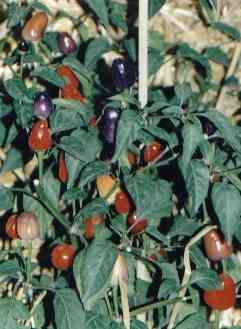
|
|
Chinese five-coloured paprika cultivar.
|
The bright red colour of ground paprika is a remaining
impression for everyone who has had an opportunity to visit marketplaces
(Turkish
çarşı,
Arabic
suq [
سوق],
Persian
bazar [
بازار])
somewhere in the area from Morocco to Turkey to Iraq to Northern India. In these
regions, the spice is equally valued for taste as for colour. Its subtle,
sweet flavour is compatible with hot and spicy dishes, but also mild stews
profit greatly from it. Since paprika contains significant amounts of sugar, it
must not be overheated, as the sugar will quickly turn bitter. Frying paprika powder
in hot oil is therefore a critical procedure that must last no longer than a few
seconds.
A spice mixture from Central Asia employing paprika is baharat, a fiery composition from the countries around the Gulf
of Persia. The Arabic word baharat [بهارات]
is an archaic plural to bahar [بهار] spice
and thus means the spices
so the baharat blend is just
the (canonical) spice mixture
. As many other mixtures from
Arabic-influenced cuisines (see grains of paradise
on Tunisian gâlat dagga,
cubeb pepper on
Moroccan ras el hanout and long
pepper on Ethiopian berbere), baharat
contains both pungent and aromatic spices: black
pepper, chiles and paprika provide a pungent
background and nutmeg, cloves, cinnamon and cardamom contribute aromatic flavour; the mixture
furthermore contains cumin and coriander fruits, all of which are ground to a fine
powder. Baharat is mainly used for mutton dishes; most
commonly, the mixture is shortly fried in oil or clarified butter to intensify
the fragrance. In the Eastern Mediterranean, a simpler baharat
mixture is used that consists mainly of black pepper
and allspice.
Further East, paprika powder plays in increasingly smaller rôle; the easternmost area with paprika usage
is in North India. There, paprika powder is popular in Muslim cookery; for example, the signature food of
Kashmir is rogan josh [روغن جش, रोगन जोश],
mutton braised in a highly aromatic joghurt sauce, which owes its bright red colour and its mild heat to that special paprika powder.
Also, sikh kabab [سیخ کباب, सीख कबाब]
(minced meat on a spit grilled over charcoal fire) is flavoured and coloured with liberal amounts of paprika.
The same type of paprika is also used in the Hindu cuisines of the Northwest, particularly in Rajasthan.
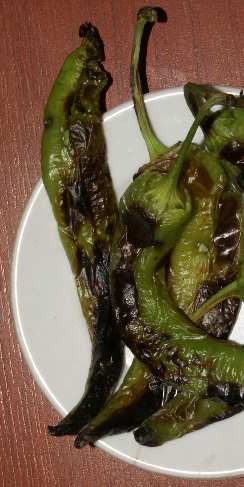
|
|
Turkish grilled paprika
|
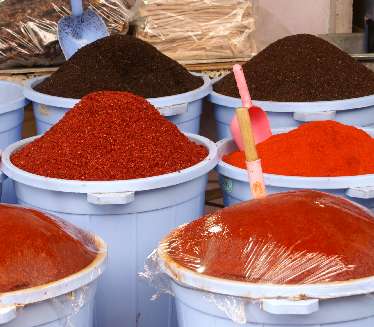
|
|
Turkish paprika products: Front row paprika paste, behind ground dried paprika, in the back isot
|
Turkish cuisine displays significant compentency in cooking with paprika; possibly, the Ottoman Turks
encountered paprika quite early in the 16.th century, when the fruit was introduced to Portuguese settlings
in Hormuz and India; subsequently, paprika was quickly adapted to Turkish cooking.
In Turkey, pul biber is coarsely ground red paprika (also known as paprika flakes
) with intensive colour and flavour,
and a varying (but not extraordinary) degree of heat; it is used for cooking and particularly as a table
condiment, in a rather universal manner. Slowly braised foods like güvec (meat stewed with vegetables, particularly aubergines)
owe both flavour and hue to this type of paprika powder. It is also sprinkled liberally on the famous döner kebap, meat grilled on a rotating spit and served with bread.
Turkey has an interesting and quite unique variant of dried paprika powder called isot, which is made from
slowly oven-dried paprika fruits with a dash of salt; it is very dark brown, almost black, and shows a somewhat mature, almost fermented taste.
The best isot allegedly comes from the Şanlıurfa region, and it is most used in the Eastern part of the country.
It is used for çiğ köfte, a salad or snack prepared from cracked wheat (bulgur) and, rather
uniquely, fatless raw beef or mutton. Depending on the recipe, it is either rather dry and shaped to small balls, or it is almost fluid and
stuffed into rolls made from raw lettuce leaves.
Apart from the beef and the rather fiery seasoning, çiğköfte is comparable to other Near Eastern salads employing
cracked wheat, like tabbouleh and kısır (see parsley).

|
|
Turkish paprika products: Front row paprika paste, behind ground dried paprika, in the back isot
|
In addition to the dried paprika, Turkish cuisine also uses a bright red, aromatic paprika paste (biber salçası or simply salça),
which is available either mild (tatlı sweet
) or hot (acı). This type of
paprika paste is needed for the kısır salad (see parsley).
Tiny, quite pungent pods are harvested unripe and pickled in vinegar, which makes them into a table condiment (acı biber turşusu).
A rather large-fruited (15 cm), slim, pointed paprika type commonly known as sivri biber (pointed pepper
) or just biber
is often toasted, almost charred, over open fire to yield a perfect companion for grilled meats (kebap);
it has strong paprika flavour with smokey overtones, and may be surprisingly hot.

|
|
Hungarian cherry paprika (cseresznyepaprika)
|
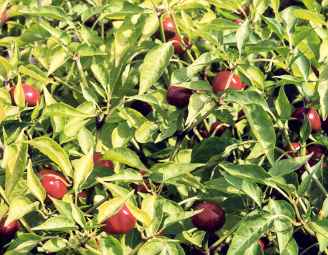
|
|
Ripening cherry paprika
|
In Europe, paprika consumption is highest in Hungary and the Balkan countries,
less so in the Mediterranean, although some Spanish cultivars are famed (e. g., romesco and
the smoked Pimentón de la Vera). Even in those
European countries where hot chiles are disliked,
mild paprika types are valued as spice and especially popular for stewed or
barbecued meat and sausages. Paprika appears very frequently in commercial spice
mixtures.
It is not fully clear how the paprika arrived in Hungary,
but there is no doubt that the fruits were brought by the Turks in the 17.th
century, although the details are covered in various legends. Anyway, paprika
became quickly naturalized and has since proved an important flavour in
Hungarian cuisine. Still, some of the
best paprika cultivars of Europe are found in Hungary. An example is the
cherry paprika (cherry pepper
, cseresznyepaprika),
which has medium pungency (well, enough for most Europeans) but an excellent
flavour. This is one of the few non-American
paprika cultivars that can rival with Mesoamerican, particularly Mexican,
varieties. Cherry paprika can be dried and ground to a rather piquant paprika
powder, but in Hungary it is also eaten fresh and served as a kind of
table condiment. Lastly, it is very good pickled.
In Hungarian cuisine, different grades of paprika of varying pungency are used.
There are four basic grades:
különleges (special paprika),
csemege (delicatesse paprika),
édesnemes (sweet and noble paprika) and
rózsa (rose paprika).
Other than in México, these grades do not stem from distinct paprika
cultivars. The differences entirely come from the degree of ripeness
at harvest time and selection of pods by size; a chief point accounting
for the differences in pungency, colour and flavour is the proportion
of mesocarp (fruit wall), placenta and seeds which are ground together.
Különleges consists only of selected mesocarps
of fully ripe harvested, flawless paprika fruits; it
has a mild, delicate flavour, no pungency and a bright red colour.
In the more common grade csemege, the paprika flavour is
stronger, but it is still almost non-pungent. Édes–nemes has a subtle pungency, and rózsa is a piquant product with still good paprika
flavour, but markedly reduced colour; for its production, the fruits may
be plucked in a partially ripened state and be subject to an artificial
ripening process. Rózsa is
the grade most often available in other countries.
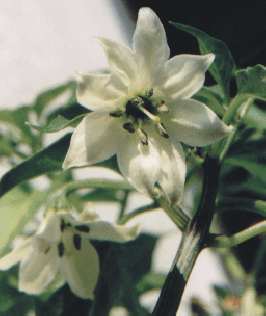
|
|
Flower of C. annuum (Poblano)
|
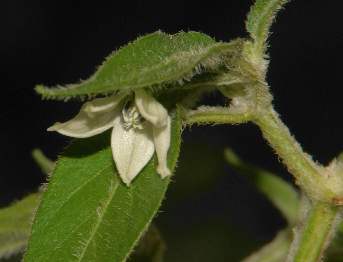
|
|
Flower of C. annuum (Serrano)
|
To produce the milder grades, one needs much mesocarp, but only little
veins, placenta and seeds. The excess material is then ground to yield a hot
paprika powder (csípős) of orange–brown
colour and poor flavour; it is almost as pungent as common
chile powders, e. g., cayenne pepper.
In some literature, additional grades between rózsa and
csípős are mentioned
(gulyás, erős).
The Hungarian national dish
is gulyás,
which basically means cattleman
, and is also used to name the
cattleman’s favourite food: a thick and spicy soup made from beef, varying
vegetables (potatoes, carrots) and a particular type of pasta. To get the
right flavour and colour,
chopped onions are lightly fried in pig’s lard;
when the onions take a pale yellow colour, paprika powder is stirred in
and fried for a few more seconds before the remaining ingredients are
added. It is the art of goulash making to fry the paprika powder as long
as possible (to bring out its flavour), but stop the frying before it
turns bitter (which may happen very quickly).

|
|
Flower of C. annuum (Serrano)
|
This food has been much copied but also bastardized in the cooking of other
European countries; the internationalized
versions (goulash) are often
stews, not soups, made of beef or pork in a thick sauce made from
onions and paprika powder. In Austria, often
caraway is used for the seasoning. In Hungary,
such a dish would not be called a gulyás but a
pörkölt; a pörkölt with
sour cream added is a paprikás (pronounced paprikash).
Another well-known Hungarian food is lecsó,
a tasty stew from nonpungent capsicum vegetable, tomatoes,
garlic (which has no place
in gulyás!) and sometimes smoked bacon.
Lecsó is flavoured with hot paprika. A similar
vegetable stew in Serbia and Croatia is called đuveč [ђувеч].
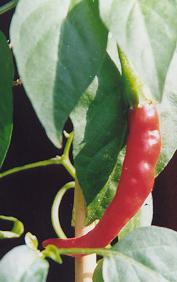
|
|
Eastern European paprika
|
Nonpungent paprika types grown as a vegetable (often called bell pepper in
English, although they aren’t peppery at
all) are an Eastern European invention, probably from Bulgaria. They
arose quite lately, at the end of the 19.th century, and have become
a popular food all over the world since then.

|
|
Chiltepín fruits
|
Although chile and paprika do not stem from Central
America, the art of their cultivation has reached its highest peak in
México. In México, the species Capsicum annuum
is grown almost exclusively; it is unique among all Capsicum
species because there are both pungent and mild cultivars. See
chile for a discussion of the other species.
It is often speculated that the variety called tepín or chiltepín
(chilctepín, flea chile
, C.
annuum var. aviculare or C.
annuum var. glabrisculum), which
grows wild in the North Mexican desert (Sonora) and also in parts
of the USA (Texas), might have been
put to cultivation by an ancient Mexican people and has, thus, become
the actual ancestor of all cultivated C. annuum varieties.
By this line of reasoning, the chiltepín would
be the ancestor of most of today’s chile and paprika cultivars grown
on all continents with the sole exception of Southern America, where still
today botanically different species dominate (see chile for details).

|
|
Chile tepín, flower and ripe fruit
|
Yet, following that thought, it would be difficult to
explain (i) how the chiltepín could have
travelled from its diversification locus (Amazon basin) that far into the
North without human help, and (ii) why all early records of chile
cultivation point to Central and Southern México, never to the
North. So the chiltepín is more probably a
cultivar that has escaped back into the wild, not an original wild form.
The chiltepín is quite hot and can be fiercely
hot; it is much used for North Mexican cuisine and has quite recently
established itself on the US market, fueled by the large number of
Mexican immigrants and the general interest in Mexican and
other spicy food. It should be noticed that the tepín is still
a wild plant, and the entire crop is collected from the wild. So far, all
attempts for cultivation in commercial scale have failed.
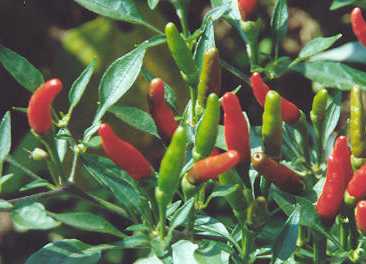
|
|
Chile pequín plant with ripening fruits
|
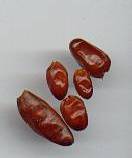
|
|
Dried chile piquin
|
In México, there exists a continuous spectrum of paprika pods, from the
very mild to the very hot. Confusingly, all of them are usually referred to as
chiles, and indeed they are all one botanical species (with
the exception of habanero-type chiles in Yucatán,
which belong to species Capsicum chinense).
This situation contrasts with what is found in other countries, where only hot
(chile
) and mild (paprika
) types are known, but no intermediates.
To keep the terminology consistent, I will deviate from established literature
and not use the term chile for mild
varieties, but stick to the name paprika for all mild to medium hot
Mexican chiles. The border between those two terms is
somewhat arbitrary: I will fix it just above jalapeño
level.
Mexican chiles and paprika are known and identified by
their local names. The smallest of these are just one or two centimeters long:
Besides the above-mentioned tepín, there is
a whole class of cultivars called pequín
or piquin with small, elongated and quite hot
fruits. Then, there are types with long, pointed fruit which are of
biting heat, e. g., the chile de arbol. On the other
side of the spectrum, there are large-fruited
varieties with pods larger than 15 centimeters: Anaheim,
chilaca, poblano, and
New Mexico.
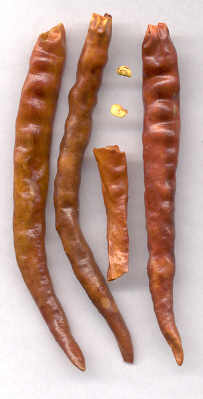
|
|
Dried Mexican de arbol chiles
|
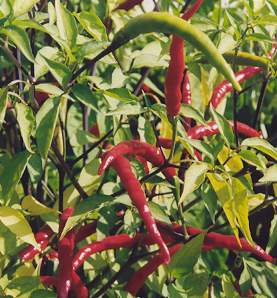
|
|
Ripening Mexican de arbol chiles
|
Mexican cooks
often use several varieties of fresh and/or dried chiles/paprikas for one
recipe, because their chief goal in chile usage is not so much heat but
flavour, which varies strongly between the different varieties.
The resulting flavours are very characteristic and cannot be found in any other
cooking style.
Some of the Mexican capsicum cultivars are rather large, thick-fleshed
and show only low heat. One of the most popular
varieties is the poblano, whose large size (up to 12 cm
long and 7 cm broad) and moderate heat allow for usig them as a vegetable:
The famous recipe chiles rellenos consists of red
or green poblanos stuffed with cheese, which are dipped in
batter, deep-fried and served with a tomato sauce. Poblanos
and other thick-fleshed varieties cannot simply be dried, but must be roasted
and peeled or smoked before using. According to the exact drying procedure,
the same capsicum cultivar may be sold under different names; e. g., a dried poblano may be an ancho or a mulato. Dried capsicum mostly stems from ripe fruits, whereas
fresh ripe capsicum is often hard to obtain because of short shelf life.
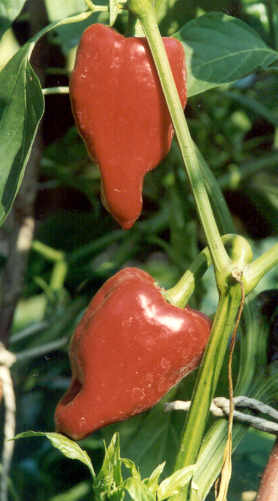
| |
Poblanos are large-fruited paprikas
with a fruity flavour and a mild, pleasant pungency.
|
|
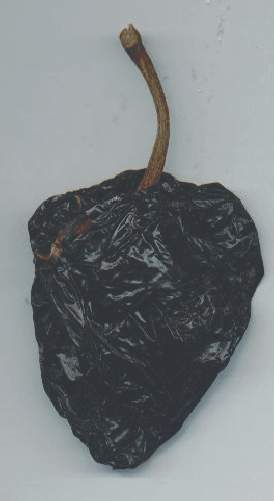
| |
The ancho is a dried poblano; it plays an eminent
rôle in the cuisines of México.
|
|
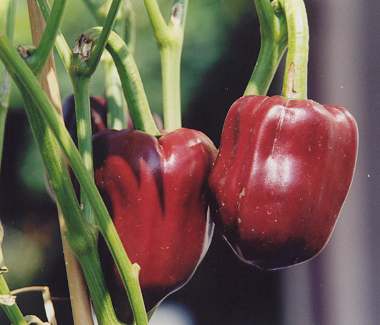
|
|
Fresh Chilhuacles negros
|
Much of the secrets of Mexican cookery lies in the properties of dried
capsicum. Roasting enhances the natural aroma of paprika, smoking may add new
accents and given the multitude of different cultivars, a Mexican cook
has almost unlimited possibilities to make his choice from. Salsas (see long coriander) may be
made from either fresh or dried capsicum, or both. For sauces whose preparation
involves long simmering periods, dried capsicums are unanimously preferred.
Often, the dried capsicums are roasted again and rehydrated in hot (but not
boiling) water before usage. After soaking, the chiles are then ground and fried
in oil or lard till they form a thick, dark brown paste with intensive flavour.
Though somewhat time- and labour-intensive, this procedure alone brings out the
best flavour from the dried paprikas/chiles. In such recipes, mild varieties
(like ancho, mulato and
pasilla, which are often referred to as
the holy trinity
) are commonly combined with less aromatic, but more
pungent cultivars like the de arbol or the smoky
chipotle. The results are often phantastic.

| |
The chile pasilla (also called
chile negro) is one of the most common
Mexican chiles.
|
|
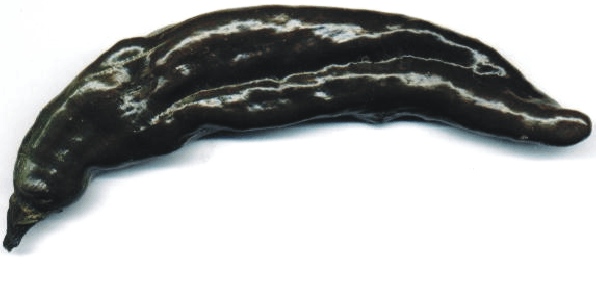
| |
Its fresh form, called chilaca, is dark green, almost
black; it is used much more rarely.
|
|

| |
The Mexican pasilla de Oaxaca chile, dried and smoked
|
|
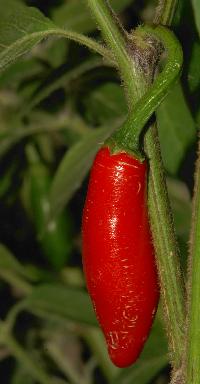
|
|
Ripe serrano chile
|

|
|
Fresh jalapeño-chiles
|

|
|
Ripe jalapeño chiles
|
One of the best known Mexican varieties is the
jalapeño, named after
Jalapa (or Xalapa),
the capital of the union state of Veracruz in South Eastern México.
Jalapeños
don’t have a particularly characteristic taste, but are more pungent than the
former-mentioned varieties with large fruits (though still much milder than
typical South American or Asian chiles).
Jalapeños are usually eaten still unripe (green),
and in the fresh state; very often, they are coarsely chopped (optionally
deseeded) and used to pep up salsas (see also
long coriander) or just sprinkled over foods on
the table. They derive their attraction not so much from the taste, which
is somehow green
and immature, or their medium pungency, but rather
from their crispy texture which sets interesting accents especially in
salsa or guacamole.
The serrano chile is in both shape and flavour similar
to the jalapeño, yet it is much smaller and also
more pungent, reaching almost the heat level of a green Thai
chile. Serranos (the name
means mountain chile
) are typical for rural Mexican cooking where
they often replace the milder jalapeños.

|
|
Mexican chipotle chiles
|
Drying ripe and perishable fruits is difficult,
especially fleshy ones like
jalapeños which rot quicker than they dry. To
preserve ripe chiles, Mexican Indians have developed a smoking procedure that
yields products of unique culinary value. Dried and smoked chiles are a very
special flavouring, typical for Central America, and impart an incomparable,
warm–spicy–smoky flavour to the foods.
The term chipotle in principle may denote any smoked chile,
as Náhuatl poctli just means smoke
. Yet this name has
now come to mean smoked jalapeños almost
exclusively. To produce chipotles, one starts with ripe red
jalapeños and smokes them slowly for up to two days;
commonly, pecan or hickory wood are used, though some believe that the best
chipotles are made with mesquite smoke.
The final smoked chiles combine good paprika aroma,
significant heat and intense smoke flavour, all of which make them an
indispensable ingredient for the indigenous cuisines of México,
especially Central México. Moreover, chipotles have
become very popular in the USA and are a key factor for the cooking style of
the South West states (Texas, New Mexico, Arizona), as they provide a delicious
balance of heat and smoky flavour.
Chipotles may be used in the same way as
anchos or mulatos, i. e., rehydrated,
puréed and fried, which yields very spicy products. More commonly, they
are just steeped in sauces or used in the powdered form. Ground
chipotles are an excellent last-minute seasoning.
Chipotles en adobo are whole chipotles
stewed in a thin, well-seasoned tomato sauce; they may be used as a snack
or garnish for those who can stand them, or used as a flavouring for other
foods. Together with the adobo liquid, they can be
processed into a puree to yield a very flavourful dip.

|
|
Dried chile pulla from México
|

|
Dried chile guajillo from México
|
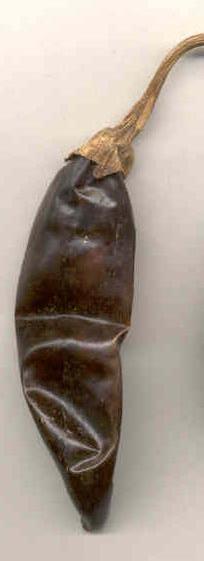
|
|
Dried New Mexico chile (chile pasado)
|
Mexican mole sauces are very complex mixtures of
several different capsicum cultivars plus a large variety of other
ingredients; preparation takes quite a time, in some cases even days. Most moles call for dried chiles. Oaxaca, a province in Central
México, is regarded the home of these sauces: In Oaxaca, seven classical
recipes (los siete moles) are traded from generation to
generation.
Most moles contain different kinds of nuts and seeds,
which add body, furthermore spices like cinnamon
and allspice, dried fruits and aromatic vegetables
(tomatoes, tomatillos). Corn flour (masa harina) or dried
tortillas are used to thicken. It is essential to select the
proper chiles: For example, mole negro (black mole
)
needs the costly and rare chilhuacle negro, but
mole amarillo (yellow mole
) is prepared with fresh
güero chiles, a pale green and less aromatic variety.
The most famous recipe is mole rojo (red mole
, also
known as mole Poblano) which is flavoured using the
holy trinity
, i. e., ancho, mulato
and pasilla; see sesame for
details. Another concoction, green mole (mole verde), owes
its particular flavour to Mexican pepper-leaves and
fresh green jalapeño chiles.
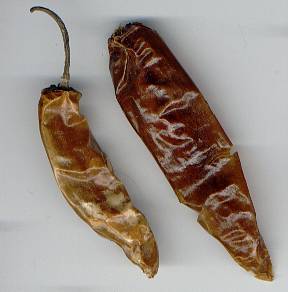
|
|
The Mexican costeño amarillo chile, dried
|
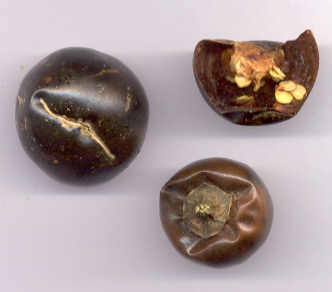
|
|
Dried chile cascabel
|



























